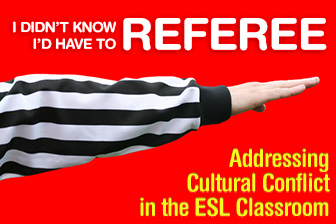Teaching U.S. Academic Values in the Classroom (Yes, You Must Come to Class, but that is Not Enough)


In fact, it became so heated that one of them finally asked the other if he’d like to “take it outside.” The other students broke into shocked and nervous laughter—shocked probably because this was class of seminary students, young men studying for the priesthood... A few years later in a different class and different discussion, on the topic of gender relationships, a young lady from Kuwait spoke up in front of the class for the first time to express the view that women were “weaker” than men. She probably just meant physically weaker, in general, but this position brought howls of outrage from the other women in the class as well as some of the men—gender issues being a rather touchy point to most Americans. Nadja, the Kuwaiti woman, appeared so crushed by the experience—this free and frenzied exchange of ideas that is, regrettably, so much a part of U.S. discourse—that I spent a long time talking to her after class, assuring her that the other students had been attacking the idea put forth, not her, personally—but this still did not completely resolve it for her; she still felt attacked, as I would have. Both of these situations are among my least proud teaching moments. In both cases, I failed to respond to and contain the situation adequately because I just didn’t see it coming—and by the time the conflict had developed, it was too late to do much about. In short, I wasn’t trained to referee.
What are some of the ways the instructor can, first, prevent such cultural conflicts and, next, respond to them once they have developed?
Start off the term with the rules of discussion or debate. I’ve called them the “Rules of Engagement”—before you even engage in debate, the students have to understand and agree to these rules. You can even include the students in establishing them: most will agree that it’s important not to interrupt, to listen, to be clear, etc. Establishing these rules is important because you can then refer back to them as necessary: “Remember we agreed to listen to each other? Let’s wait until Nadja is finished.” It’s very hard to establish these rules “on your feet” in the moment you need them!
Before tackling a debate like capital punishment or abortion, which are likely to get heated, have students practice on “harmless” topics first: Cats or dogs? Vanilla or chocolate? People can only get so outraged on these topics--but many students when debating them will pretend commitment to or moral outrage on the topic: “As a lifelong ice-cream eater, I must say I understand yet object to your views on vanilla…” At the same time, they are practicing such skills as recognizing the other party’s viewpoint, stating their own clearly, and supporting it, while maintaining respectful language. Developing these skills will help them when debating such topics as gun control, which typically draw much stronger responses.
In both of the situations described at the beginning of the article, I failed to react appropriately because I was too surprised. But it is necessary for instructors to respond to such situations, even if it is just to say, “Stop. This isn’t appropriate.” To not say anything is to suggest you condone the behavior. Even though I talked to the Nadja after class for quite awhile the day of her unfortunate introduction to American-style debate, our relationship was never quite the same; she didn’t trust me again, rightly seeing me as having failed to contain this situation.
As I couldn’t really pretend with Nadja that the conflict hadn’t happened, it isn’t possible to pretend so with a class as well. The conflict has occurred; whatever damage there is has been done, and the class cannot pretend otherwise. Therefore, it is necessary to discuss the situation and debrief and derive whatever teachable moments there are from it (there almost always are some.) One night in a graduate course in education a few years ago, two students there got a little heated in their exchange of ideas on—ironically—classroom management. Because I was at this time more prepared for such exchanges, I waited until before break and then asked the small class to wait. I simply reminded them of their obligations as both students and educators to maintain a respectful environment and that they were invited to share their views, but this necessarily implied listening respectfully to others as well. The students readily agreed, and there were no further incidents in this class.
Such incidents as recounted in this article can become part of continuing dialogue in the class, especially if the class syllabus deals with sensitive issues. The dialogue should be focused on skills required in a civilized society and academic community—to hear each other out, to listen to other viewpoints without attacking, to state one’s own without becoming defensive, and so on. It is these skills that are so lacking in our society that mastering them will put students ahead of much of the public (including their leaders).
However, our role as educators is not only to seek peace but to maintain it, as well as to teach our students how to.
Have you addressed conflict in the classroom? If so, how did you deal with it?